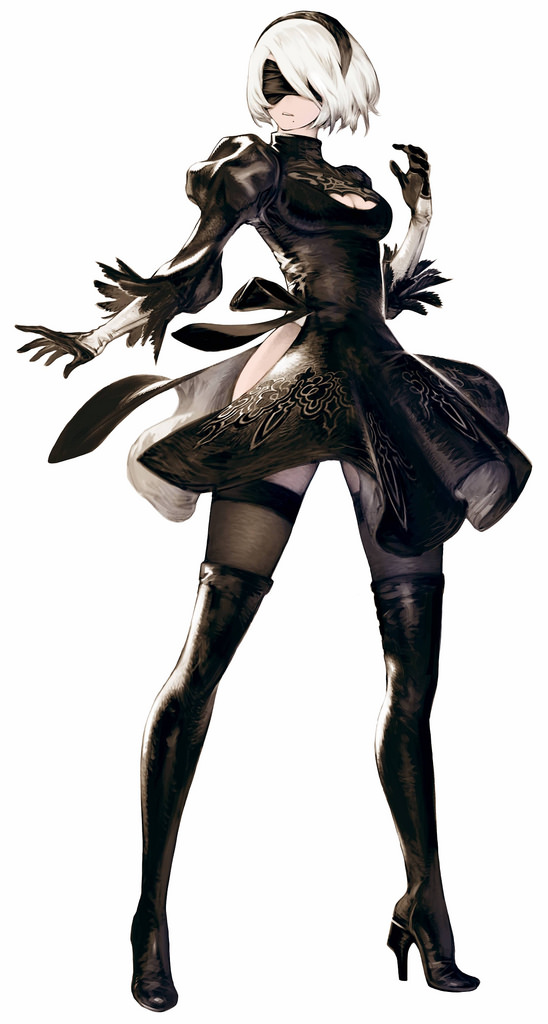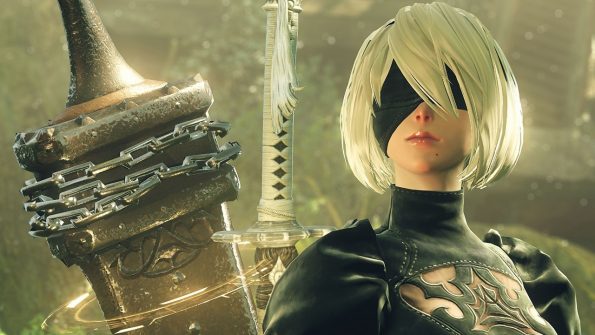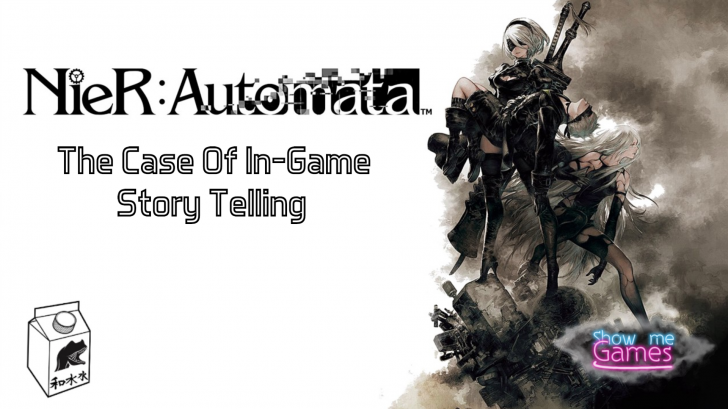Nier: Automata & The Case for In-Game Story Telling
In its visual styling of Nier: Automata’s racy, android protagonist 2B, Platinum Games has helped realize the idea of the “Teenage Boy Character Design School”. Sure, she’s a strong, independent heroine, the like of which is so necessary in today’s landscape, but she’s also a character who can’t climb a ladder without revealing an inadvertent “up-skirt” shot. A design choice surely included with the intention of attracting a certain kind of gamer.
At this point, it would be all too easy to dismiss the game for its sexist depiction of women in video games, a further reminder of the inequality inherent in the video games industry. Except to “do it” like that, would be to do it a most grave injustice. Because here’s the thing: It might just be the most important game released this year. Of course, it isn’t an obvious contender for such a title, but underneath its hyper sexualized facade, is a game teaming with ideas and depth, the like of which I haven’t seen in years

On the surface, Nier: Automata is an action RPG, in which you, a sword wielding, scantily clad femdroid are tasked with slicing and dicing your way to the games fated conclusion. Yes, it toys with genre tropes, a 3rd person action romp first, a side scrolling platform game the next, a twin sticks shooter thereafter before shedding its skin once more to morph into a bullet hell inspired shmup. It’s a game that wears a lot of different suits, and to be frank it wears them all very well. The thing is, that’s not what sets it apart as a game that demands you stand up and take notice of it. Competence in a range of different genres is impressive sure, but it’s within the games medium specific narrative tools that Nier: Automata sets itself apart as a truly unique beast.
Video games have long tried to establish where they sit in the hierarchy of artistic mediums. Lacking the intellectual respect bestowed upon literature whilst simultaneously being viewed as an altogether lesser art form than film. Video games have struggled to find a method of story telling to truly call their own. For years, the video game industry has looked to ape the language of film, leaning heavily on cinematic idioms to tell stories, and it’s a strategy that has worked undeniably well. If a game is hailed as cinematic, its almost always done so in an overwhelmingly positive sense. A quick look at the Uncharted series is all the evidence you need to back up such a theory.
 The Uncharted games, for all their moxie, still seem overly concerned with telling a cinematic story. There’s a beginning a middle and an end. 21st century story telling down to a tee. Along the way our hero will face adversity, defy overwhelming odds and meet a colorful assortment of character, who’ll make the entire experience an altogether more enriching ride. Is it original? Hell no. Does it need to be? Probably not. Nathan Drake is what happens when a developer (in this case Naughty Dog) decides to create an interactive take on Indiana Jones, and that’s fine, because lets be honest, who hasn’t at any one time wanted to be Indiana Jones!? My issue is that most games follow this trend, and they do so in a manner that inadvertently means that they fail to embrace the unique attributes of video games that sets the medium apart. It’s largely fine, because most people love film, and even more so than that, it’s a narrative technique we’re all inherently conditioned to “understand”. What Nier: Automata does so well, is that it embraces the aspects of video games that makes them unique. More simply put, it tells a story that could only ever exist in the confines of a video game world.
The Uncharted games, for all their moxie, still seem overly concerned with telling a cinematic story. There’s a beginning a middle and an end. 21st century story telling down to a tee. Along the way our hero will face adversity, defy overwhelming odds and meet a colorful assortment of character, who’ll make the entire experience an altogether more enriching ride. Is it original? Hell no. Does it need to be? Probably not. Nathan Drake is what happens when a developer (in this case Naughty Dog) decides to create an interactive take on Indiana Jones, and that’s fine, because lets be honest, who hasn’t at any one time wanted to be Indiana Jones!? My issue is that most games follow this trend, and they do so in a manner that inadvertently means that they fail to embrace the unique attributes of video games that sets the medium apart. It’s largely fine, because most people love film, and even more so than that, it’s a narrative technique we’re all inherently conditioned to “understand”. What Nier: Automata does so well, is that it embraces the aspects of video games that makes them unique. More simply put, it tells a story that could only ever exist in the confines of a video game world.
For those of you unfamiliar with Nier: Automata, the story picks up in the distant future, at a time when the human race has all but vanished from Earth itself; the aftermath of an alien invasion in which robotic “machines” were used to fight the war effort. Humanity has retreated to the moon, and from there, conducts its strategic counter attack using androids to fight back against the alien machine lifeforms. You take control of unit 2B, the sexy, blindfolded, android ninja I mentioned at the very start of this lengthy tome. Now the specifics of the story itself are solid: an interesting yarn examining just what it is to be human, but the story itself isn’t what sets the game apart as a narrative trail blazer. Its the way in which the story is told.
Play through the game once, and you get a neat little narrative arc, the like of which most games offer. Play it again however and things start to get interesting. You see, during your second play through, the perspective shifts to that of a different character. It’s the same story sure, but the game offers it up to you with an entirely fresh perspective, filling out some of the narratives more juicy incidentals. Second play through done, and you have a fully formed story that you’ve experienced through two different sets of eyes, and more importantly through two different campaigns. Its a method that makes the entire cast infinitely more relatable, and forces us ,the player, to pivot our expectations in a wildly inventive manner. This is how all New Game+ runs should be treated. It allows you to keep all the skills you’ve developed through your first play through, and marries it to a fresh perspective that, while familiar, feels entirely new and enticing.
But it doesn’t end there.
Start the game for a third time, and the narrative shifts again, only this time, to a completely new story. A sequel of sorts, that looks to continue the tale you started during your first two playthroughs. It’s a mid mangling way of crafting a story, one that could only be done in the medium of video games, and I for one, love it.

There are 26 endings in Nier: Automata, although 21 of them are non cannon jokes slipped in by director Taro Yoko as a kind of visual nod to the player, that for whatever reason, somewhere you’ve fucked up. That leaves you with 5 “true” endings, that you’ll need to complete the game five separate times to see, and thereby flesh out the story of Nier: Automata in its entirety. Now that sounds like a lot, and as someone who routinely doesn’t revisit games after finishing them the first time round, it was a prospect I wasn’t much looking forward to. The thing is, you never really feel like you’re playing through the same campaign every time you restart. Each of your five playthroughs is different enough to make you feel like you’re starting a totally fresh version of the game, and its this fact, this distinctly “video gamey” method of story delivery that sets Nier: Automata apart from its peers, and makes its particular brand of storytelling so important to the landscape of video games in 2017.
If you’d like to follow more of Dan Smash’s stuff, check out his youtube channel KaiJuice













